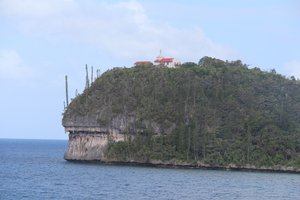Advertisement
Published: April 19th 2018

 1
1
Chapel on the promontoryBlog 29
Easo, Lifou, New Caledonia, April 17, 2018 – Weather forecast: mostly sunny; temperature 27°C 90%, wind 19kts (5 Beaufort)
Our port of call today was the island of Lifou and the community of Easo. According to the documentation provided by the Shore Excursion Team the name “Easo” in the local Drehu language means “smoking fire”. The name was derived from the fact that whalers lit fires on shore to render the fat into oil from the cetaceans they had harpooned in the area during the decade of 1860-1870.
Catholic missionaries came to the island in 1858 and established a chapel, Notre Dame de Lourdes, on the promontory overlooking Santal and Jinek bays. The chapel was clearly visible from the ship as we sailed into the Santal Bay.
Our shore excursion took us to the Lifou Vanilla House at the Mucaweng Vanilla Plantation. This working plantation was established in 1983 by Felix Bole who used cuttings from Lifou’s English missionaries.
Our tour guide provided a full explanation how vanilla is produced; it is a very hands-on intensive process. The process starts by taking cuttings from

 2
2
The Plantationhealthy vines and planting them. During the next three years you have to train the vines into loops on their supporting trees. The reason for creating loops in the vines is to help the farmers when it comes to assisting in the pollination and harvesting stages.
After three years the vines are ready to flower and since the island does not have pollinators human intervention is required. Each vine can have up to a hundred flowers on it which need a human to press the male and female parts together. It then takes nine months for the bean to mature. Once harvested the beans are sorted and weighed. Then they are briefly dunked in boiling water for 3 minutes to scald them. This process activates the bean’s chemical components. The beans are next packed away in wooden chests where they sweat for 48 hours.
Beans are then spread out on screens and placed out in the sun where they need two months to dry out. The screens need to be stored inside each night to prevent dew gathering on them and of course they need to be retrieved whenever it rains. Once the initial

 3
3
Vanilla vinedrying is over the beans require another 4 months of drying on their screens inside the building. The next stage is referred to as conditioning and the beans are packed away in wooden boxes for 4 to 6 months. The final stage sees the beans hand sorted, measured and bunched by category. This very long process explains why pure vanilla costs so much.
Advertisement
Tot: 0.053s; Tpl: 0.011s; cc: 7; qc: 38; dbt: 0.0275s; 1; m:domysql w:travelblog (10.17.0.13); sld: 1;
; mem: 1mb

 1
1
 2
2
 3
3
Yvonne
non-member comment
Fascinating
Yes, and the price is set to go sky high - but I still won't use anything else. I can always tell when it's not real vanilla.